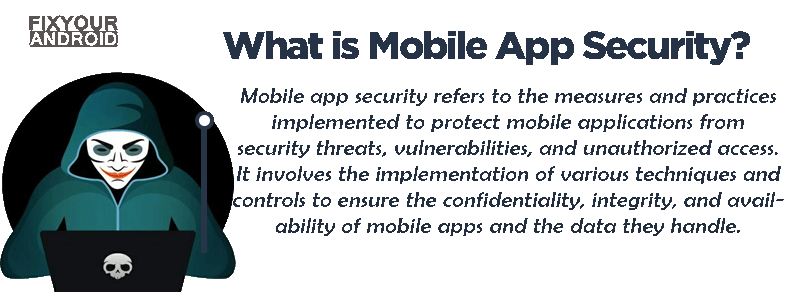Security Threats in Our Mobile Apps and Ways of Curtailing Them
Several businesses, companies, and brands have used mobile apps for various purposes. The software developers they hire to develop their mobile apps do that bearing the reason for developing the mobile app in mind.
The mobile app can be used to make transactions, learn or have the products or services the companies offer to be more accessible to its users.
With the availability of mobile apps, several mobile security issues and solutions must be implemented. A hacker who can successfully hack or access information on a person’s profile on a mobile app may do what they please with that information.
This makes it important for people to be aware of mobile security threats and prevention.
What is Mobile App Security?
Mobile app security means how mobile apps are secured from external issues or threats. These threats could be in the form of malware, cyberattacks, and digital fraud, among others. The focus here is to ensure that mobile apps run well on every platform like Windows, iOS, and Andriod without any issues.
Mobile App Security Threats
There are many mobile security issues and solutions available presently in our world today. But, before looking at the solutions available, here are some of the mobile app security threats you may be subject to.
Lack of data security
A major mobile app security threat is a lack of data security. On most mobile apps, people input personal information and sometimes their private data like card details depending on the transaction that they want to carry out. Cybercriminals are aware of this fact.
When the mobile app does not have enough security measures in place, the coding used was poor, no encryption for data storage, or the software components are outdated, it is easier for cybercriminals to access private data.
Sometimes, the software developers may have deleted the app or an individual no longer uses it, when the data already stored on it is not well protected, cybercriminals can access this data for their use.
Malware attacks
Cyber hackers know how easy it is for them to use malware, which is malicious code to steal the personal information of people. With the information they get, they can use it for any purpose.
Therefore, most times, they include this malware in a mobile app so that when an individual downloads the app and installs it, they can access the individual’s data.
Sometimes, they cannot include such malware in an authentic app. So, most of these hackers make an app- a replica of a popular app that thousands or millions of people are downloading.
When it is impossible to differentiate the replica, those unlucky enough to download the replica with the malicious code will suffer for it.
Lack of Transport Layer Protection (TLS)
With the help of the client-server architecture, mobile apps can exchange data well and easily. So, these data can be well exchanged between the person who is carrying the mobile device and accessing the mobile app and the internet.
While exchanging or transferring these data, cyber attackers can look for the vulnerabilities or loopholes that will help them get the data that is stored in the local network or Wi-Fi.
They can do this through the malware attacks they put in place where there is no Transport Layer Protection (TLS).
To ensure that this is not the case with the mobile app you publish, you should use a CA certificate provider who can help you include SSL/TLS security on the transport layer of your app.
Some CA certificate providers will include solid cipher suites for you also.
Video Editing on Smartphones vs. Computers: Which is Better?
Putting these certificates in place will make it difficult for data leakage, account theft, phishing, main-in-the-middle-attack, and other forms of issues like site exposure and the bad press or reputation that will bring to the company who published the mobile app for users to download.
Poor Encryption
Another mobile security threat is the absence of encryption in the mobile app. Encryption makes it difficult for cybercriminals to access data because the data was scrambled and they cannot decipher the data without a key.
Without proper encryption in place on your mobile apps, it will be easy for cybercriminals to gain access to and use the data of individuals the way they want.
It is important to make use of strong algorithms, save encryption keys correctly, using secure communication protocols, among others to ensure that encryption is in place correctly on mobile apps.
Client-side injections
Software infections, which can lead to authentication issues and the ability for the cyber attackers to fully access data sometimes, come from the user’s end because they are vulnerable.
For example, some mobile apps ensure that the users on the client side are the ones to authenticate themselves, which leads to important data being stored on a smartphone or laptop that no security has been put in place.
What is often advised is that when authenticating app data especially when you want to log into banking apps and social media apps or storing data on the server side, when you want to transmit the data, you should use a hash value to do that.
The reason for using a hash value is that it creates room for you to verify if the data is good or genuine especially when the channel used to send that data is not secure.
Do Android phones need antivirus or internet security apps?
Ways to Mitigate Mobile App Security Threats
Write secure codes with the use of the best coding practices
Most cybercriminals can reverse engineer codes for their various purposes. It is now up to the software developer to ensure that they use best coding practices to write secure code, which will ensure that cyber attackers cannot use the vulnerabilities in the code to include bugs or perform other cyberattacks.
Therefore, when you are done with your coding process, you must test the code. This will enable you to see any bugs or vulnerabilities that will make it easy for cyber attackers to access data.
Doing this may be tiring and time-consuming, but it is very important. It is also advisable that you should regularly have code audits, which will help you, see if there are any loopholes in the code.
Use Code Signing Certificate to Secure Your Application
As an app publisher, it is necessary to authenticate your app before you put it on the market. The authenticated application brings more downloads to your desk. To do so, an app developer needs a Code Signing certificate.
Once the code is signed; it ensures that the code is not altered since it was signed. With the Code Signing certificate, people downloading your app gets assurance about the app’s authenticity.
Android Spyware Detection | 11 Best Free Spyware Detection Apps For Android
Use of Authentication and Authorization
An important method of preventing mobile security issues is by asking users to use authentication and authorization when accessing mobile apps. With authorization, the right permission is checked while authenticating before access can be granted to certain resources on the application.
Authentication is the use of SSO flows, passwords, usernames, and access to prove the identity of an individual before granting them access to a mobile app. This will help filter out cybercriminals.
There are several ways that authorization and authentication can be included in mobile apps.
They include:
- Making use of SSL/TLS certificates that are good and working to help protect data.
- There should be the use of biometric identification like fingerprints and retinas. Doing this can make people set up good two-factor authentication because even when a cybercriminal can correctly input the password, it will be impossible for them to pass the fingerprint or retina check.
- You can ensure that users change their passwords frequently. Also, encourage the use of strong passwords, which include symbols, numbers, and alphabets. It should not be one that can be easily guessed.
- When users want to log into their account, apart from inputting their password, they should also include a one-time password that will be sent to their email or their password.
Store data securely
Another way of mitigating mobile app security threats is by storing data securely; this will help you earn the trust of your mobile app users. Do not just make use of your device memory to store the mobile application’s data because it puts the data at risk of access by cybercriminals.
To store data securely, include an option for a user to delete their data when they are uninstalling the app. Also, store private data under internal storage. Do not grant access to every mobile application that seeks access to your data.
However, if there are data that is not sensitive, you can store such data in your external storage and ensure that access to the data is well-managed especially if you will be granting access to apps that needs them.
Additionally, there are times when mobile apps access files that are corrupt under external storage. Mobile apps should have logic in place that will handle data or files that are corrupt.
Conclusion
The mobile security issues and solutions discussed above must be used to ensure that mobile apps are well protected. People will always make use of a mobile app for different purposes. Therefore, both the users and the software developers and publishers should ensure that the mobile apps are good enough for people to use without any form of threat of cyberattacks or compromise of their data.


